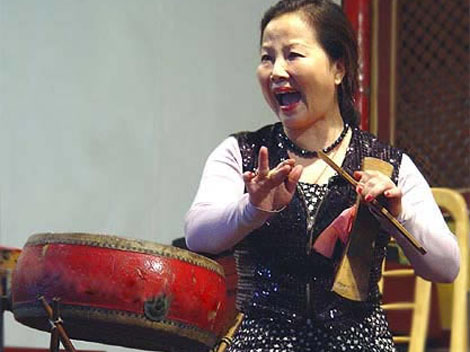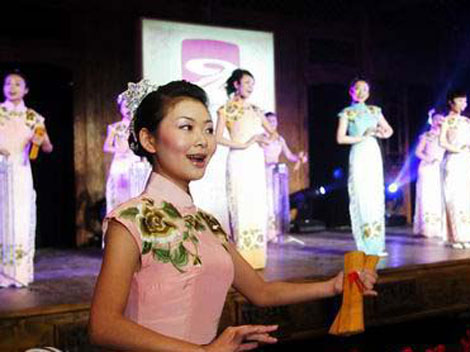
In the early days, this form of aria was called changxiaoqu (small tunes). It also had other names according to whether the performer uses a yueqin, a four-stringed plucked instrument with a full-moon-shaped sound box, or a pipa as accompaniment. Since the 1950s, Sichuan qingyin has been formally used as the proper term to designate arias sung in the Sichuan dialect. These are popular in cities and rural areas around Chengdu, the capital of the province, as well as on the wharves and in the port cities along the Yangtze River.

Sichuan qingyin developed from popular songs and ditties of the Ming and Qing dynasties as well as from Sichuan folk songs. Rich in melodies, there are over 100 items in the repertoire. The composition of vocal music is divided into qupai and banqiang. The traditional way of singing Sichuan qingyin is for the performer to sit at a table, facing the audience. The singer is usually a woman, and she is flanked by a yueqin or pipa player on the left and by a player of the wanwanqin (a bowl- shaped plucked instrument), erhu (a two-stringed bowed instrument) or xiaohuqin (a small stringed instrument) on the right. The performances tend to take place in tea houses and theaters.
There are also itinerant singers who offer performances in the street or in hotel lobbies, especially after the mid-Qing Dynasty. Amateurs calling themselves "friends of qingyin" became a common sight, singing arias and playing the ptoa or yueqin. Some achieved considerable Success with high levels of attainment. Organizations of amateurs promoted the development of the Sichuan Quyi in no small measure, in the 1960s and 196Os the sitting posture was replaced by a standing posture. The singers who performed in theaters, beat their own drums, made of bamboo and snake skin, or shook wooden clappers accompanied by small bands of musicians playing such instruments as pipa, gaohu, erhu and zhonghu. The musicians played minor roles and joined in the choruses. There is an extensive repertoire of traditional themes in Sichuan qingyin, including Zhaojun Outside the Frontier, The Nun Leaves Her Mountain Convent, The Broken Bridge, Daiyu Burns Her Poems and Flying Kites. Contemporary themes are also prominent, in such items as The Cuckoo sings and On the Sixth day of the Sixth Month.
Source:
http://traditions.cultural-china.com/en/17Traditions5140.html





